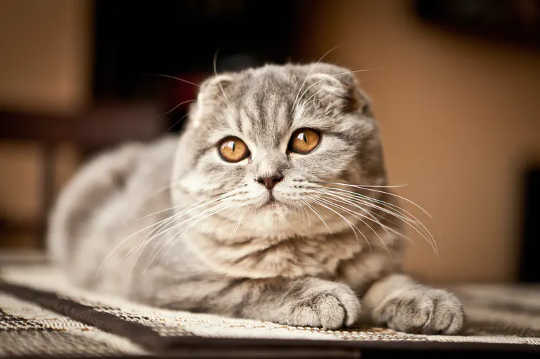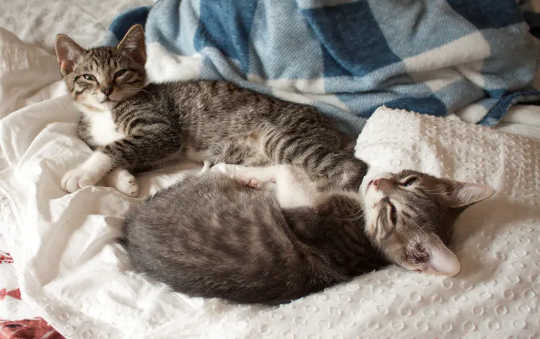
Breeds with exaggerated features include the Scottish fold. Andrey Tairov/Shutterstock
For decades, humans have been selectively breeding cats and dogs to exhibit exaggerated features – particularly in their faces. When it comes to cats, the very flat, round faces of the modern Persian and Exotic Shorthair are classic examples. These breeds are likely a result of humans’ preference for infant-like features that may directly tap in to our nurturing instincts.
While it might be cute for humans to look at, there are various downsides for the animals when it comes to looking this way. These flat-faced features, known as “brachycephalic”, are usually associated with a very shortened muzzle, narrowed airways, excessive skin folding and shallow eye sockets. This can cause all sorts of health issues as well as breathing difficulties and, in dogs, an increased risk of fatal conditions such as heatstroke.
But health problems are not the only difficulties these traits might be causing. In a new study, my colleagues and I have shown breeding for these exaggerated features may negatively affect animals’ ability to effectively communicate and express themselves.
Cats facial expressions can change, based on how they are feeling. Their faces may look different depending on whether they are fearful, frustrated or in pain, for example. However, drastic alterations to their underlying facial structure can disrupt the clarity of their expressions.
Get The Latest By Email
After analysing pictures of almost 2,000 cat faces, we found brachycephalic face types appeared to display more “pain-like” expressions, even though these flat-faced cats were not considered to be in pain. This was particularly the case for Scottish Folds, whose facial features scored higher for pain-like expressions even when compared to domestic short-haired cats that were actually in pain.
On top of this, there is a huge variation across breeds when it comes to the shape of their faces – for example the Siamese and Abyssinian have more narrowed, elongated or “dolichocephalic” faces compared to both brachycepahlic cats as well as the more proportioned or “mesocephalic” faces of domestic short-hairs. We found the locations of facial landmarks known to change position during different expressions varied significantly just based on the cat’s breed, even when their faces were in a “neutral” position. Issues of effective communication may therefore not only affect flat-faced cats.
What these findings demonstrate is that we may not only be attracted to animal faces that look cute or infant-like, but potentially also to those that look more vulnerable, injured or in distress. Unfortunately, what it means for our pets is that we may continue to prefer – and even encourage – the existence of breeds with serious health problems that may also struggle to communicate with us and potentially other animals.
Such individuals may end up receiving greater attention from us than they would prefer, because their appearance motivates us to want to attend to them. Equally, we may also miss when they may actually be in pain, because we may not be able to tell the difference from their usual appearance. In such cases, it may be better to try to understand how our pets are feeling based on their behaviour or posture rather than their faces.
But this is potentially also problematic, given that we have altered many other physical features of our pets, such as their general body size and shape and the length of their limbs and tails. These issues are unlikely to be limited to just cats, given that other domesticated species, particularly dogs, exhibit similar types of selection for extreme features.
Picking a cat
The value of pet companionship has never been so great. Responsible and regulated sources of pet acquisition, such as rehoming centres and registered breeders, have been inundated with new enquiries throughout the pandemic.

Kittens have become increasingly popular during the pandemic. Central Midfielder/Wikimedia Commons, CC BY-SA
But with longer than usual waiting lists and large proportions of owners admitting to impulse-buying their new pets, many people may have obtained their new companions from less reputable sources such as puppy or kitten farms.
Prices of kittens and particularly puppies remain at a premium, paving the way for increases in these types of disreputable but highly lucrative breeding practices that meet the high demands for designer pets.
Our research shows people should think carefully before choosing a particular breed of cat or dog. If purchasing a pet from a breeder, ensure that the desired breed does not typically suffer from chronic health problems and choose the breeder carefully.
From a communication perspective, it may be a good idea to avoid purchasing breeds with any kind of heavily exaggerated features including very flattened or elongated faces – but also miniature breeds, those with shortened legs or those lacking a tail, for example. For people who already own a breed with these types of features, it’s important to be aware of the potential issues they might face when interacting with other animals and how we may also struggle to correctly interpret their behaviour and expressions.
About the Author
Lauren Finka, Postdoctoral Research Associate, Nottingham Trent University
This article is republished from The Conversation under a Creative Commons license. Read the original article.
books_pets







